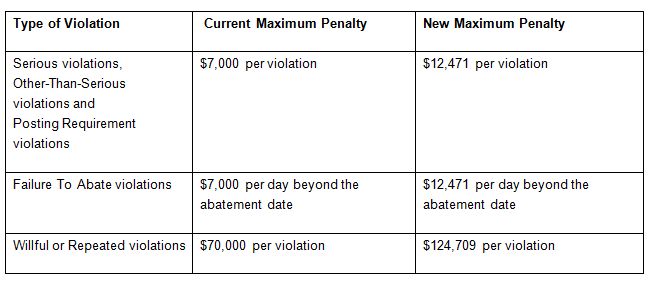Effective August 1, Occupational Safety and Health Administration (OSHA) fines will increase by more than 78 percent — the first OSHA fine increase in a quarter century.
Until now, the Occupational Safety and Health Act (OSH Act) was exempt from a federal mandate that certain fines and penalties be periodically adjusted for inflation. Going forward, OSHA penalties will now be adjusted annually based on the Consumer Price Index. Virtually all state OSH agencies will follow suit.
The penalty increase will apply to citations handed down by OSHA after August 1, 2016, if the related violations occurred after November 2, 2015. The new maximum penalties are as follows:

This is the latest of several recent enhancements that OSHA has employed in its enforcement of the OSH Act's General Duty Clause, which requires employers to provide employees with jobs and workplaces that are "free from recognized hazards that are causing or are likely to cause death or serious physical harm."
In 2015, OSHA expanded the list of severe injuries that all employers must report to OSHA. It also implemented an "Enforcement Weighting System," which counts complex inspections the same as multiple simple inspections for performance tracking purposes. The change encourages enforcement personnel to take on complicated inspections without worrying about whether they are meeting goals for individual inspections. The result has been inspections of employers that have not been traditional targets of scrutiny.
In December 2015, the OSHA entered into a Memorandum of Understanding with the Environmental Crimes Section (ECS) of U.S. Department of Justice that encourages federal prosecutors to work with ECS to pursue as environmental crimes worker safety violations under the OSH Act, the Mine Safety and Health Act and the Migrant and Seasonal Agricultural Worker Protection Act. Environmental crimes carry far heavier criminal sanctions than OSH Act violations alone.
Also, effective November 1, 2016, OSHA will impose a new notice requirement on employers to inform workers of their right to report work-related injuries and illnesses without fear of retaliation. Employers will also be required to implement procedures "that are reasonable and do not deter workers from reporting" workplace injuries and illnesses.
Finally, effective January 1, 2017, establishments with 250 or more employees that are required to keep injury and illness records must electronically submit injury and illness records to the OSHA on an annual basis. Employers with between 20 and 249 employees will be required to electronically submit their 300A annual summary forms.
With the implementation of the new penalty matrix and the pending notice of nonretaliation mandate, now is a good time for employers to demonstrate to employees that their safety is of paramount importance.
Employers can do this by taking action to:
- Update safety programs to ensure they are in compliance with state and federal standards.
- Conduct a comprehensive assessment of the workplace for hazards and remediate any found.
- Update employee safety training modules.
- Review safety committee rosters, policies and procedures.
- Reinforce the reporting policy and procedures and the policy of nonretaliation for good-faith reports of suspected violations.
- Ensure that all safety measures, training and inspections are well documented.
The content of this article is intended to provide a general guide to the subject matter. Specialist advice should be sought about your specific circumstances.

